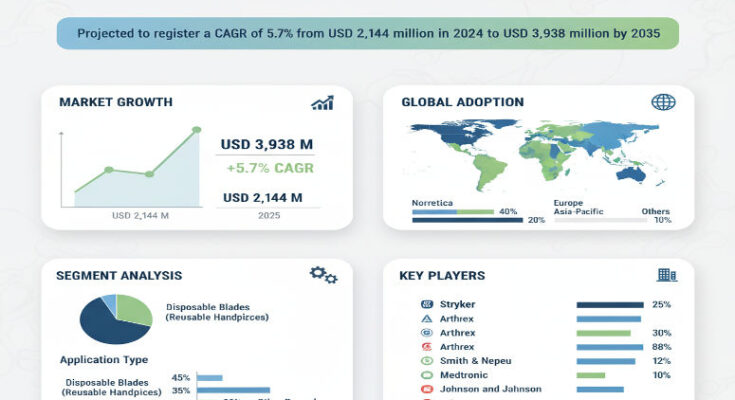The global arthroscopic shaver market was valued at approximately USD 2,144 million in 2024, and is forecast to reach around USD 3,938 million by 2035, registering a compound annual growth rate (CAGR) of about 5.7% over that period. This expansion results from increasing prevalence of orthopedic conditions, rising demand for sports medicine interventions, and growing adoption of minimally invasive surgical (MIS) procedures which favor tools that reduce recovery time while enhancing surgical precision.
Drivers & Innovation Trends
Key drivers fueling market growth include the increasing rate of joint injuries—knee, shoulder, and hip—in both aging populations and among younger demographics engaged in sports. Surgeons, healthcare systems, and patients alike are favoring arthroscopic methods thanks to their lower morbidity, shorter hospital stays, and quicker rehabilitation compared with open surgeries. Technological innovation is also pushing the market forward: newer shaver designs with adjustable speed controls, enhanced safety features, improved suction and fluid management, ergonomic hand pieces, and even disposable systems to mitigate infection risk are all gaining traction.
Further, the rise in outpatient surgical centers and ambulatory services is driving demand for compact, high-performance shaver systems. Manufacturers are increasingly focused on features that boost efficiency, reduce setup time and improve convenience, including lightweight designs, better control systems, and compatibility with integrated imaging or visualization platforms.
Market Segmentation & Application Focus
By product type, the market includes control systems, shaver hand pieces, accessories (blades, burrs, suction units), and others. Among these, shaver hand pieces are central due to their direct role in soft-tissue removal and debridement; their precision, design, and ease of use heavily influence surgical outcomes.
Application-wise, knee repair dominates, driven by high incidence of meniscus tears, ligament damage, osteoarthritis, and a large volume of arthroscopic knee procedures globally. Shoulder and hip repair segments are also growing robustly, especially as awareness of sports injuries and arthroscopic repair techniques increases. End users are primarily hospitals, but ambulatory surgical centers and specialized orthopedic clinics are increasing their share, particularly as MIS becomes more accessible and outpatient surgery models expand.
Regional Insights: United States, Europe, Asia-Pacific
United States is a market leader, owing to mature healthcare infrastructure, high rates of orthopedic and sports medicine procedures, strong reimbursement frameworks, and rapid adoption of minimally invasive tools. Regulatory requirements for device safety, preference for high-quality outcomes, and patient demand for quicker recovery also push adoption.
In Europe, growth is solid, especially in countries with aging populations, strong regulation of medical devices, and increasing investment in healthcare infrastructure. Nations such as Germany, UK, and France show strong demand for arthroscopic shavers, particularly in orthopedic hospitals and specialized clinics.
The Asia-Pacific region is forecast to exhibit among the highest growth rates. Rapid healthcare infrastructure expansion, rising medical tourism, increasing awareness and accessibility of surgical care, and growing incomes are enabling greater demand. Countries like China and India are expected to drive this regional growth, both by increasing volume of procedures and as domestic manufacturing and supply chains mature.
Key Players & Competitive Landscape
Major companies vying for leadership in the arthroscopic shaver market include Karl Storz, Arthrex, CONMED Corporation, Stryker Corporation, Smith & Nephew, DePuy Synthes (Johnson & Johnson), Zimmer Biomet, Medtronic plc, Richard Wolf GmbH, and Mitek Sports Medicine.
These companies compete by innovating in product design (lighter, more ergonomic hand pieces, better control systems, integrated suction), regulatory compliance (sterility, safety, disposability), service and support, pricing, and distribution networks. Recent strategic moves include an emphasis on disposable or semi-disposable systems to reduce infection risk, and improved imaging / visualization integration to assist surgeons. Some players also invest in training programs and surgeon outreach to build familiarity and trust with next-generation device features.
Challenges & Barriers
The market does face several challenges. High cost of advanced shaver systems, especially those with premium control systems or disposable components, can limit adoption in lower-income regions or smaller hospitals / clinics. Regulatory requirements for medical devices are stringent, particularly in markets like the U.S. and EU, which increases time and cost for approval. Further, surgeon preference, training, and awareness can lag behind technological advancements; adoption of newer systems depends heavily on clinical outcomes and trust. Supply chain constraints for specialized components (e.g. high-precision blades, suction units, sterilizable materials) can also lead to delays or cost pressure. Lastly, competition from alternative surgical techniques or instruments (including other MIS tools or non-invasive modalities) remains a factor.
Browse Full Report: https://www.factmr.com/report/arthroscopic-shavers-market
Future Outlook & Strategic Recommendations
From 2025 to 2035, the arthroscopic shaver market is projected to nearly double in value. To succeed, companies should prioritize R&D in ergonomics, infection control (disposable or easily sterilizable components), enhanced imaging and control interfaces, speed, and precision. Strategic focus on markets with growing incidence of orthopedic disorders—aging populations, sports injury prevalence—and on expanding access in Asia-Pacific and Latin America will be valuable.
Manufacturers should also invest in partnerships with hospitals and clinics for surgeon training, in service and maintenance networks, and in flexible product offerings (premium vs cost-competitive models) to reach broader markets. Adoption of single-use or mixed-use models, improved materials, better sterilization, and regulatory readiness will also differentiate winners.



